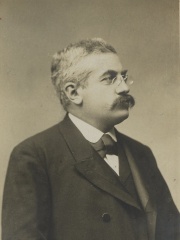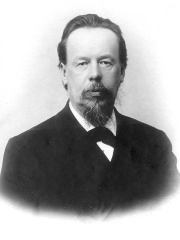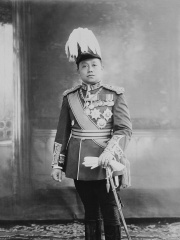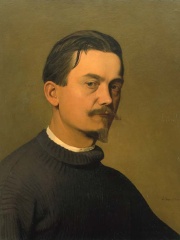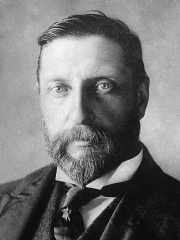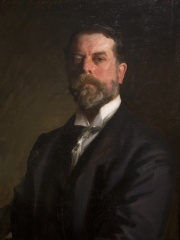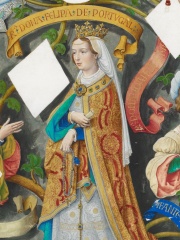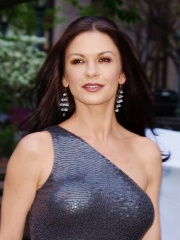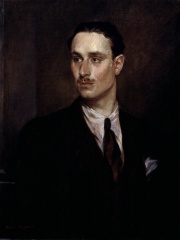POLITICIAN
George Curzon, 1st Marquess Curzon of Kedleston
1859 - 1925

 George Curzon, 1st Marquess Curzon of Kedleston
George Curzon, 1st Marquess Curzon of Kedleston
George Nathaniel Curzon, 1st Marquess Curzon of Kedleston (11 January 1859 – 20 March 1925), known as Lord Curzon (), was a British statesman, Conservative politician, explorer and writer who served as Viceroy of India from 1899 to 1905 and Foreign Secretary from 1919 to 1924. Curzon was born in Derbyshire into an aristocratic family and educated at Eton College and Balliol College, Oxford, before entering Parliament in 1885. In the following years, he travelled extensively in Russia, Central Asia and the Far East, and published several books on the region in which he detailed his geopolitical outlook and underlined the perceived Russian threat to British control of India. In 1891, Curzon was named Under-Secretary of State for India, and in 1899 he was appointed Viceroy of India. Read more on Wikipedia
His biography is available in 53 different languages on Wikipedia (up from 51 in 2024). George Curzon, 1st Marquess Curzon of Kedleston is the 2,936th most popular politician (down from 2,543rd in 2024), the 729th most popular biography from United Kingdom (down from 546th in 2019) and the 150th most popular British Politician.
George Nathaniel Curzon, 1st Marquess Curzon of Kedleston, was a British statesman and diplomat. He served as Viceroy of India from 1899 to 1905. He was Secretary of State for Foreign Affairs between 1919 and 1924.
Memorability Metrics
Page views of George Curzon, 1st Marquess Curzon of Kedleston by language
Among POLITICIANS
Among politicians, George Curzon, 1st Marquess Curzon of Kedleston ranks 2,936 out of 19,576. Before him are Emperor Kōan, Alexandru Ioan Cuza, Pepin of Italy, Melisende, Queen of Jerusalem, Ko Yong-hui, and Sigebert I. After him are Sigebert III, Alfonso the Battler, Thorismund, Thein Sein, Alcetas I of Macedon, and Alfonso III of Aragon.
Most Popular Politicians in Wikipedia
Go to all RankingsEmperor Kōan
427 BC - 291 BC
HPI: 69.88
Rank: 2,931
Alexandru Ioan Cuza
1820 - 1873
HPI: 69.88
Rank: 2,932
Pepin of Italy
777 - 810
HPI: 69.88
Rank: 2,933
Melisende, Queen of Jerusalem
1105 - 1161
HPI: 69.88
Rank: 2,934
Ko Yong-hui
1952 - 2004
HPI: 69.88
Rank: 2,935
Sigebert I
535 - 575
HPI: 69.88
Rank: 2,936
George Curzon, 1st Marquess Curzon of Kedleston
1859 - 1925
HPI: 69.88
Rank: 2,937
Sigebert III
630 - 656
HPI: 69.87
Rank: 2,938
Alfonso the Battler
1073 - 1134
HPI: 69.87
Rank: 2,939
Thorismund
420 - 453
HPI: 69.87
Rank: 2,940
Thein Sein
1944 - Present
HPI: 69.87
Rank: 2,941
Alcetas I of Macedon
550 BC - 600 BC
HPI: 69.87
Rank: 2,942
Alfonso III of Aragon
1265 - 1291
HPI: 69.87
Rank: 2,943
Contemporaries
Among people born in 1859, George Curzon, 1st Marquess Curzon of Kedleston ranks 18. Before him are Yuan Shikai, Billy the Kid, Verner von Heidenstam, Sholem Aleichem, Alexandre Millerand, and Jean Jaurès. After him are Jerome K. Jerome, Pierre Janet, Hugo Junkers, Alexander Samsonov, Anna Ancher, and Alexander Stepanovich Popov. Among people deceased in 1925, George Curzon, 1st Marquess Curzon of Kedleston ranks 25. Before him are Felix Klein, Léon Bourgeois, Alexander Friedmann, Hjalmar Branting, Vajiravudh, and Félix Vallotton. After him are Aleksey Kuropatkin, Wong Fei-hung, Mohammad Ali Shah Qajar, Oliver Heaviside, H. Rider Haggard, and John Singer Sargent.
Others Born in 1859
Go to all RankingsYuan Shikai
POLITICIAN
1859 - 1916
HPI: 76.77
Rank: 12
Billy the Kid
MAFIOSO
1859 - 1881
HPI: 75.91
Rank: 13
Verner von Heidenstam
WRITER
1859 - 1940
HPI: 74.01
Rank: 14
Sholem Aleichem
WRITER
1859 - 1916
HPI: 73.55
Rank: 15
Alexandre Millerand
POLITICIAN
1859 - 1943
HPI: 72.08
Rank: 16
Jean Jaurès
POLITICIAN
1859 - 1914
HPI: 71.82
Rank: 17
George Curzon, 1st Marquess Curzon of Kedleston
POLITICIAN
1859 - 1925
HPI: 69.88
Rank: 18
Jerome K. Jerome
WRITER
1859 - 1927
HPI: 69.70
Rank: 19
Pierre Janet
PSYCHOLOGIST
1859 - 1947
HPI: 69.17
Rank: 20
Hugo Junkers
ENGINEER
1859 - 1935
HPI: 68.67
Rank: 21
Alexander Samsonov
MILITARY PERSONNEL
1859 - 1914
HPI: 68.55
Rank: 22
Anna Ancher
PAINTER
1859 - 1935
HPI: 68.11
Rank: 23
Alexander Stepanovich Popov
INVENTOR
1859 - 1906
HPI: 68.00
Rank: 24
Others Deceased in 1925
Go to all RankingsFelix Klein
MATHEMATICIAN
1849 - 1925
HPI: 72.08
Rank: 19
Léon Bourgeois
POLITICIAN
1851 - 1925
HPI: 71.48
Rank: 20
Alexander Friedmann
MATHEMATICIAN
1888 - 1925
HPI: 71.05
Rank: 21
Hjalmar Branting
POLITICIAN
1860 - 1925
HPI: 70.35
Rank: 22
Vajiravudh
POLITICIAN
1880 - 1925
HPI: 70.34
Rank: 23
Félix Vallotton
PAINTER
1865 - 1925
HPI: 69.96
Rank: 24
George Curzon, 1st Marquess Curzon of Kedleston
POLITICIAN
1859 - 1925
HPI: 69.88
Rank: 25
Aleksey Kuropatkin
POLITICIAN
1848 - 1925
HPI: 69.75
Rank: 26
Wong Fei-hung
MARTIAL ARTS
1925 - 1925
HPI: 69.01
Rank: 27
Mohammad Ali Shah Qajar
POLITICIAN
1872 - 1925
HPI: 68.84
Rank: 28
Oliver Heaviside
MATHEMATICIAN
1850 - 1925
HPI: 68.83
Rank: 29
H. Rider Haggard
WRITER
1856 - 1925
HPI: 68.70
Rank: 30
John Singer Sargent
PAINTER
1856 - 1925
HPI: 68.56
Rank: 31
In United Kingdom
Among people born in United Kingdom, George Curzon, 1st Marquess Curzon of Kedleston ranks 729 out of 8,785. Before him are John Rhys-Davies (1944), Philippa of Lancaster (1360), Antony Hewish (1924), Albert Finney (1936), Geoffrey Hinton (1947), and William Shockley (1910). After him are James Edward Smith (1759), Herbert C. Brown (1912), Aubrey Beardsley (1872), Catherine Zeta-Jones (1969), Robert II of Scotland (1316), and William Beckford (1760).
Others born in United Kingdom
Go to all RankingsJohn Rhys-Davies
ACTOR
1944 - Present
HPI: 69.92
Rank: 723
Philippa of Lancaster
COMPANION
1360 - 1415
HPI: 69.92
Rank: 724
Antony Hewish
ASTRONOMER
1924 - 2021
HPI: 69.91
Rank: 725
Albert Finney
ACTOR
1936 - 2019
HPI: 69.90
Rank: 726
Geoffrey Hinton
COMPUTER SCIENTIST
1947 - Present
HPI: 69.89
Rank: 727
William Shockley
PHYSICIST
1910 - 1989
HPI: 69.89
Rank: 728
George Curzon, 1st Marquess Curzon of Kedleston
POLITICIAN
1859 - 1925
HPI: 69.88
Rank: 729
James Edward Smith
BIOLOGIST
1759 - 1828
HPI: 69.84
Rank: 730
Herbert C. Brown
CHEMIST
1912 - 2004
HPI: 69.84
Rank: 731
Aubrey Beardsley
WRITER
1872 - 1898
HPI: 69.84
Rank: 732
Catherine Zeta-Jones
ACTOR
1969 - Present
HPI: 69.83
Rank: 733
Robert II of Scotland
POLITICIAN
1316 - 1390
HPI: 69.82
Rank: 734
William Beckford
WRITER
1760 - 1844
HPI: 69.82
Rank: 735
Among POLITICIANS In United Kingdom
Among politicians born in United Kingdom, George Curzon, 1st Marquess Curzon of Kedleston ranks 150. Before him are Oswald Mosley (1896), Henry the Young King (1155), James III of Scotland (1451), Princess Elizabeth of the United Kingdom (1770), Neil Kinnock (1942), and Cædwalla of Wessex (659). After him are Robert II of Scotland (1316), Edward de Vere, 17th Earl of Oxford (1550), Thomas of Woodstock, 1st Duke of Gloucester (1355), Princess Augusta Sophia of the United Kingdom (1768), Michael Howard (1941), and Mary, Princess Royal and Princess of Orange (1631).
Oswald Mosley
1896 - 1980
HPI: 70.03
Rank: 144
Henry the Young King
1155 - 1183
HPI: 69.99
Rank: 145
James III of Scotland
1451 - 1488
HPI: 69.95
Rank: 146
Princess Elizabeth of the United Kingdom
1770 - 1840
HPI: 69.95
Rank: 147
Neil Kinnock
1942 - Present
HPI: 69.95
Rank: 148
Cædwalla of Wessex
659 - 689
HPI: 69.94
Rank: 149
George Curzon, 1st Marquess Curzon of Kedleston
1859 - 1925
HPI: 69.88
Rank: 150
Robert II of Scotland
1316 - 1390
HPI: 69.82
Rank: 151
Edward de Vere, 17th Earl of Oxford
1550 - 1604
HPI: 69.79
Rank: 152
Thomas of Woodstock, 1st Duke of Gloucester
1355 - 1397
HPI: 69.78
Rank: 153
Princess Augusta Sophia of the United Kingdom
1768 - 1840
HPI: 69.69
Rank: 154
Michael Howard
1941 - Present
HPI: 69.64
Rank: 155
Mary, Princess Royal and Princess of Orange
1631 - 1660
HPI: 69.56
Rank: 156
















